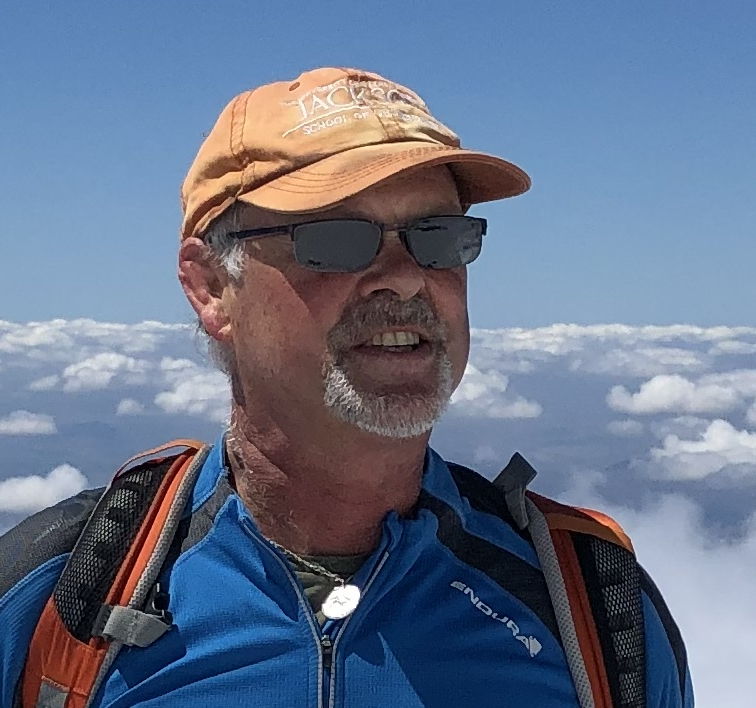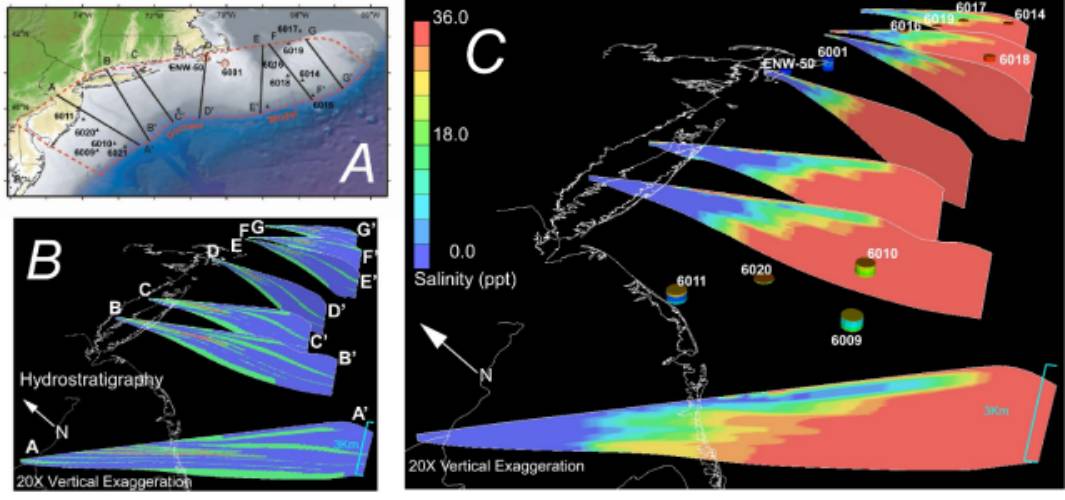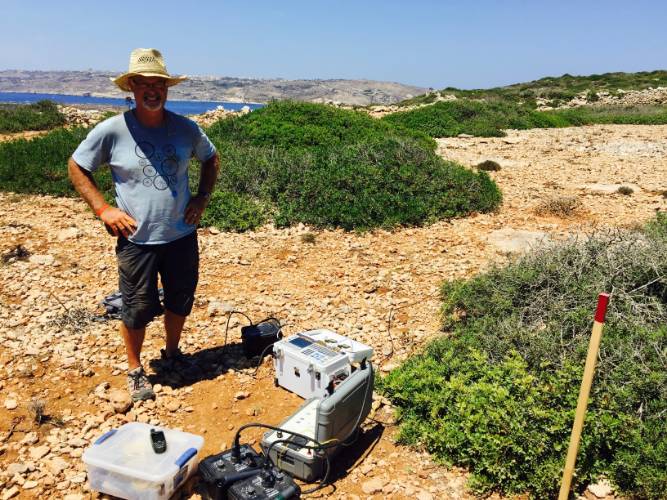
Mark Person, PhD
Professor
Earth & Environmental Science
- mark.person@nmt.edu
- 575 - 835 - 6506
- MSEC 248
Mark Person running Transient Electro Magnetic Survey on the Island of Comino, Malta, 2018.
Teaching
H510 Quantitative Methods in Hydrology: This class provides students with an introduction to analytical and numerical methods used in the hydrologic sciences. We will begin by considering relatively simple descriptions of hydrologic systems using ordinary differential equations (ODEs) where the independent variable is either space (x) or time (t). Building on what you learned in calculus, we will find both analytical and numerical solutions to these ODEs. Next we will consider more complicated hydrologic systems involving two independent variables (either x & z or x & t). These are described using partial differential equations (PDEs). We will find both analytical and numerical solutions to the PDEs.
HYD 547 Hydrological Modeling: Introduction to the finite difference (FD), finite element (FE), and Control Volume finite element methods applied to groundwater flow, heat and solute transport equations in two- (2D) and three- (3D) spatial dimensions. Analysis and synthesis of hydrologic data using mathematical modeling. Topics covered include model conceptualization and parameterization, model verification, model validation, and model prediction. Students will be exposed to the following modeling packages: MATLAB and MODFLOW. Students will be expected to develop MATLAB programs to solve a variety of simple 2D finite element and finite difference approximations of flow and transport problems.
HYD 516: Geofluids: The Role of Groundwater in Geologic Processes: This class will explore different fluid flow impelling mechanisms within the earth’s crust to depths of 10 km. Topics covered would include the role of groundwater in petroleum generation/migration, overpressure/underpressure formation in sedimentary basins, hydrothermal ore deposit formation, contact metamorphism, geothermal systems, seismicity, slope failure, sediment transport, and glaciation.
Research
Research Interests: Paleohydrology, low-temperature geothermal systems, induced seismicity, hydrogeophysics, and numerical methods.
My research interests are primarily focused on studying how groundwater flow systems evolve over geologic time scales and how subsurface flow systems affect geologic processes. One focus of my research has been centered on assessing how Pleistocene glaciations have influenced regional groundwater flow systems within sedimentary basins (Person et al. 2007; Bense and Person, 2008) and on the continental shelf (Person et al. 2003; Cohen et al. 2009; Defoor et al. 2011; Post et al. 2013). While this topic may sound esoteric, it is relevant coastal cities in arid regions of the world as well as to high-level nuclear waste repository siting efforts in countries such as Sweden, Canada, and Switzerland. Another focus of my work has been on assessing the role of groundwater flow in petroleum generation (Person and Garven, 1992; Person et al. 1995), petroleum migration (Person et al. 2012), and triggered seismicity (Zhang et al. 2013; 2017). I am also interested in how permeable fault systems affect groundwater flow and hot spring formation within the extensional tectonic settings (Bense et al. 2008; Person et al. 2012; Howald et al. 2012; Pepin et al. 2015). In 2014, my lab acquired a magnetotelluric, audio-magnetotelluric (AMT), transient electromagnetic (TEM) system from Zonge International. Zonge International (http://zonge.com/). Along with Dr. Shari Kelley of the NM Bureau of Geology & Mineral Resources and assistant professor Jesus Gomez-Velez, we are using these systems to study deep groundwater flow systems within fractured crystalline basement rocks along the Rio Grande Rift.
I have been actively involved in developing new hydrologic models that reconstruct groundwater flow system during the geologic past. Early in my career, my graduate students and I developed RIFT2D (Wieck et al. 1995; Mailloux et al. 1999), a Fortran based groundwater flow code which simulates basin evolution (i.e. sedimentation, subsidence, erosion) along with heat and solute transport within evolving continental rift basins. More recently, Denis Cohen, Peng Wang and I developed PGEOFE. This three-dimensional groundwater flow model is parallel and represents variable-density groundwater flow, heat and solute transport over geologic time scales. We used this model to simulate the emplacement of freshwater in continental shelf environments in New England during periods of glaciations (Cohen et al. 2009). Currently I am developing a control volume finite element model with professor Vaughan Voller at the University of Minnesota and Yipeng Zhang (doctoral student). We are using this hydromechanical code to study the effects of ice sheet loading on groundwater flow and rock failure/permeability increases during the Pleistocene glaciations.
 (A) Base map showing location of cross sections used to construct a three-dimensional
PGEOFE groundwater flow model of New England Continental Shelf. (B) Hydrostratigraphic cross
sections showing clay (blue), sand (green) and silt (red) deposits. (C) Computed present-day
salinity patterns on New England continental shelf. From Cohen et al. (2009).
(A) Base map showing location of cross sections used to construct a three-dimensional
PGEOFE groundwater flow model of New England Continental Shelf. (B) Hydrostratigraphic cross
sections showing clay (blue), sand (green) and silt (red) deposits. (C) Computed present-day
salinity patterns on New England continental shelf. From Cohen et al. (2009).
Three-dimensional, high-performance hydrogeologic model of the New England continental shelf, USA used by Cohen et al. (2009) to estimate the volume of freshwater sequestered within permeable sand horizons during Pleistocene glaciations and sea level fluctuations (1300 cubic km). The bottom figure in the left panel shows the PGEOFE numerical grid (about 1.3 million nodes), hydrostratigraphic units (blue, green, red patterns), bathymetry (top figure), and the Laurentide ice sheet thickness (middle figure) 21,000 years ago. The center panel shows the hydrostratigraphic unit configuration along 7 cross-sectional transects through the model domain. The right panel shows the present-day computed salinity distribution. The models were calibrated to off-shore salinity profiles from a number of wells (cylinders).
Awards
Birdsall-Dreiss Distinguished Lecturer, Geological Society of America, 1997
New Mexico Tech Distinguished Research Award, 2016
O.E. Meinzer Award, Geological Society of America, 2021
Service
Editor, Geofluids, Blackwell-Wiley, 2011-2016
Active Grants
National Science Foundation, $2.1M, 2019-2024, Collaborative Research: Exploring the linkages between Sea-Level Change, Sediment Transport and Geomorphology on Coastal Freshwater Water Sequestration Natural climatic fluctuations have induced sea-level oscillations of more than hundred meters during the past million years. As sea level rose and fell, the shoreline moved landward and seaward shifting the boundary between fresh water onshore and salt water offshore. As a result, saline groundwater is found beneath coastal zones onshore and freshwater is found offshore. While saltwater intrusion in onshore freshwater aquifers has been extensively studied, we know little about the mechanisms responsible for the emplacement of fresh to brackish water in marine environments. We estimate that there is over 100,000 km3 of freshwater stored in offshore sandy sediments around the world. To put this number in perspective, the total estimated annual groundwater withdrawal from on shore aquifers within the United States in 2015 was 117 km3. Offshore freshwater represents a vast untapped, albeit non-renewable water resource, for coastal megacities. This project will assess how the sequestration of onshore saltwater and offshore freshwater in continental shelf environments is influenced by interactions between sea level, the changing landscape, deposition of sediments, and surface and subsurface water flow over time scales of a million years or more. In order to assess these interactions, we will build a mathematical model to understand the dynamic linkages between the above-mentioned components of the Earth system. We will develop a new model using the earth science community code, Landlab, and apply the code at two field sites with vastly different local sea-level, climate, tectonic and sediment transport regimes: New Jersey and Bangladesh. Calculated sediment type and salinity patterns from these models will be compared to new and existing images from seismic data and electromagnetic (EM) data, as well as available well samples measuring salinity and age of the water. EM data is very sensitive to how salty or fresh water is. We will conduct an EM survey in Bangladesh to determine the distribution of deep onshore saltwater and freshwater in this active deltaic environment. Along with recently collected EM images from offshore New Jersey, these data will be used to inform and constrain our numerical modeling. We will also develop three-dimensional models of groundwater production for New Jersey and Bangladesh to assess whether or not offshore freshwater can be efficiently produced using horizontal wells over time scales of 30 years or more. Our study has important societal impacts for coastal cities in Bangladesh such as Chittagong and Barisal, which are growing rapidly and are running out of drinking water of acceptable quality.
NAGRA (National Cooperative for the Disposal of Nuclear Waste), $244,269, Interpreting Pressure Anomalies in Clay Rock Formations: Clay rocks are being evaluated as potential sites for the isolation of high-level nuclear wastes in Canada, Switzerland, France, Hungary, Japan, Great Britain, and Belgium. This project will conduct a global assessment of pressure anomalies in clay rocks. We will characterize the geologic properties as well as glaciation/deglaciation and erosional histories of all sites with pressure anomalies. We will try to ascertain the mechanisms for anomalous pressure generation.
Integrated Ocean Drilling Program (IODP), Expedition 406 New England Shelf Hydrogeology, $21,000,000 (Pending): In many coastal settings around the world there are vast quantities of fresh to brackish water up to 100 km offshore. Yet little is known about the timing or mechanisms of freshwater emplacement. We hypothesize that the freshwater was emplaced during sea-level low stands during the Pleistocene (2.5 Ma). In New England, USA the Laurentide Ice Sheet extended out onto the continental shelf several times providing an additional potential source to freshwater emplacement. We hypothesize that the rapid incursion of freshwater out into the continental shelf sediments in New England could have been caused by one or more of the following mechanisms: (i) Meteoric recharge during Pleistocene sea-level low-stands; (ii) Sub-ice-sheet recharge during the glacial maximums; (ii) Recharge beneath pro-glacial lakes. We hypothesize that these different recharge mechanisms can be distinguished using environmental isotope and noble gas data. In order to address these hypotheses, we plan on drilling up to 3 five hundred meter deep wells off of Martha’s Vineyard and Nantucket Massachusetts, USA during the summer of 2025. We will conduct pumping tests and date groundwater using 81Kr, 14C and noble gas methods.
Current Graduate Students
Mohamad Gad, 2020, MSc, King Faud University of Petroleum and Mineral Resources
Max Briggs, BS, Fort Lewis College
Dolan Lucero, BS Geology, University of Utah
Navis Sazeed. BS Disaster Science, University of Dhaka
Recent Graduates
Elizabeth Evenocheck, 2021, Barr Engineering, Duluth Minnesota
Melinda Horne, 2019, Montana Department of the Environment
Sofia Avendano, 2019, Los Alamos National Laboratory
Matt Folsom, MSc. 2017, ORMAT, Reno NV
John Ortiz, MSc. 2017, Johns Hopkins University
Dr. Amy Jordan, Ph.D. 2016, Neptune LLC, Los Alamos NM
David Bulter, MSc. 2014, CH2M-Hill, Seattle WA
Yipeng Zhang, Ph.D., Postdoc, University of Malta
Jeff Pepin, Ph.D., US Geological Survey, Albuquerque, NM
Papers Cited
Bense V. F., M. Person (2006), Faults as conduit-barrier systems to fluid flow in siliciclastic sedimentary aquifers, Water Resources Research, 42, W05421, doi:10.1029/2005WR004480
Bense V. F., M. A. Person, K. Chaudhary, Y. You, N. Cremer, S. Simon (2008), Thermal anomalies indicate preferential flow along faults in unconsolidated sedimentary aquifers, Geophys. Res. Lett., 35, L24406, doi:10.1029/2008GL036017
Bense V. F., M. A. Person (2008), Transient hydrodynamics within intercratonic sedimentary basins during glacial cycles, J. Geophys. Res., 113, F04005, doi:10.1029/2007JF000969
Cohen, D., Person M. , Wang, P. Gable, C. Hutchinson, D., Marksamer, A. Dugan, B. Kooi, H. Groen, K., Lizarralde, D. and R. L. Evans, Origin and Extent of Fresh Paleowaters Beneath the Atlantic Continental Shelf, 2009, Groundwater, Volume 48 Issue 1, p. 143 – 158
DeFoor, W. Person, M., Larsen, H.C., Lizarralde, D. Cohen, D. and B. Dugan, 2011, Ice sheet–derived submarine groundwater discharge on Greenland’s continental shelf, Water Resources Research, doi:10.1029/2011WR010536
Howald T, Person M, Campbell A, Lueth V, Hofstra A, Sweetkind D, Gable CW, Banerjee A, Luijendijk E, Crossey L, Karlstrom K, Kelley S, and Phillips F, 2014. Evidence for Long-Time Scale ( > 103 years) Changes in Hydrothermal Activity Induced by Seismic Events, Geofluids, doi: 10.1111/gfl.12113.
Post, V. Groen, J., Kooi, H. Person, M., Ge, S. 2013, Review: Offshore fresh groundwater reserves – A global phenomenon, Nature, v. 504, p. 71-84, doi:10.1038/nature12858
Jordan, A, Stauffer, P, Zyvoloski, G, Person, M. MacCarthy J, and Anderson, D, 2014, Uncertainty in Prediction of Radionuclide Gas Migration from Underground Nuclear Explosions, Vadose Zone J. doi:10.2136/vzj2014.06.0070
Person, M. and G. Garven, 1992, Hydrologic constraints on petroleum generation within continental rift basins: Theory and application to the Rhine Graben, American Association of Petroleum Geologists Bulletin, v. 76, p. 468–488
Person, M., Toupin, D., and Eadington, P. J., 1995, One–dimensional models of groundwater flow, sediment thermal history, and petroleum generation within continental rift basins, Basin Research, v. 7, p. 81-96.
Person, M., Dugan, B., Swenson, J.B., Urbano, L., Sttot, C., Taylor, J., Willett, M., 2003, Pleistocene hydrogeology of the Atlantic continental shelf, New England, GSA Bulletin, v. 115. p. 1324-1343.
Person M., J. McIntosh, V. Bense, V. H. Remenda, 2007, Pleistocene hydrology of North America: The role of ice sheets in reorganizing groundwater flow systems, Rev. Geophys., 45, RG3007, doi:10.1029/2006RG000206
Person M. , Hofstra, A., Sweetkind, D, Stone, W., Cohen, D., Gable, C, Banerjee, A. 2012, Analytical and numerical models of hydrothermal fluid flow at fault intersections, Geofluids, v. 12, 312–326
Person, M. Butler, D., Gable, C. W., Villamil, T., Waverek, D., and D. Schelling, 2012, Hydrodynamic stagnation zones: A new play concept forthe Llanos Basin, Colombia, Association of Petroleum Geologists Bulletin, v. 96 no. 1 p. 23-41.
Pepin J, Person M, Phillips F, Kelley S, Timmons S, Witcher J, and Gable C, 2014, Deep Fluid Circulation within Crystalline Basement Rocks and the Role of Hydrologic Windows in the Formation of the Truth or Consequences, New Mexico Low-Temperature Geothermal System, Geofluids, doi: 10.1111/gfl.12111.
Zhang, Y., Person, M., Rupp, J., Ellet, K., Celia, M.A., Gable, C.W., Bowen, B., Evans, J., Bandilla, K., Mozley, P.S., Dewers, T., and Elliot, T., 2013, Hydrogeologic controls on induced seismicity in crystalline basement rocks due to fluid injection into basal reservoirs: Groundwater, v. 51, Issue 4, p. 525–538.
Zhang, Y., S. Edel, J. Pepin, M. Person, et al., “Exploring the potential linkages between oil‐field brine reinjection, crystalline basement permeability, and triggered seismicity for the Dagger Draw Oil field, doi: 10.1111/gfl.12199
